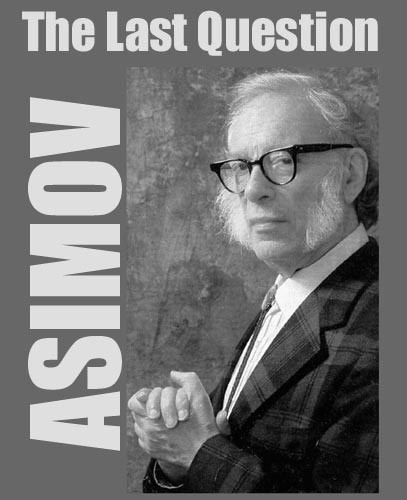9.2 /10 1 Votes9.2
Language English Publication type Periodical Originally published November 1956 Followed by Jokester Country United States of America | 4.6/5 Goodreads Publication date November 1956 Publisher Columbia Publications | |||||||||||||||||||||||||||||||||
 | ||||||||||||||||||||||||||||||||||
Similar Nightfall, All the Troubles of the World, The Complete Stories, The Bicentennial Man, The Naked Sun | ||||||||||||||||||||||||||||||||||
The last question read by isaac asimov
"The Last Question" is a science fiction short story by American writer Isaac Asimov. It first appeared in the November 1956 issue of Science Fiction Quarterly and was anthologized in the collections Nine Tomorrows (1959), The Best of Isaac Asimov (1973), Robot Dreams (1986), the retrospective Opus 100 (1969), and in Isaac Asimov: The Complete Stories, Vol. 1 (1990). It was Asimov's favorite short story of his own authorship, and is one of a loosely connected series of stories concerning a fictional computer called Multivac. The story overlaps science fiction, theology, and philosophy.
Contents
History
In conceiving Multivac, Asimov was extrapolating the trend towards centralization that characterized computation technology planning in the 1950s to an ultimate centrally managed global computer. After seeing a planetarium adaptation of his work, Asimov "privately" concluded that this story was his best science fiction yet written; he placed it just higher than "The Ugly Little Boy" (September 1958) and "The Bicentennial Man" (1976). "The Last Question" ranks with "Nightfall" (1941) as one of Asimov's best-known and most acclaimed short stories.
Plot summary
The story deals with the development of a series of computers called Multivac and their relationships with humanity through the courses of seven historic settings, beginning in 2061. In each of the first six scenes a different character presents the computer with the same question; namely, how the threat to human existence posed by the heat death of the universe can be averted. The question was: "How can the net amount of entropy of the universe be massively decreased?" This is equivalent to asking: "Can the workings of the second law of thermodynamics (used in the story as the increase of the entropy of the universe) be reversed?" Multivac's only response after much "thinking" is: "INSUFFICIENT DATA FOR MEANINGFUL ANSWER."
The story jumps forward in time into later eras of human and scientific development. In each of these eras someone decides to ask the ultimate "last question" regarding the reversal and decrease of entropy. Each time, in each new era, Multivac's descendant is asked this question, and finds itself unable to solve the problem. Each time all it can answer is an (increasingly sophisticated, linguistically): "THERE IS AS YET INSUFFICIENT DATA FOR A MEANINGFUL ANSWER."
In the last scene, the god-like descendant of humanity (the unified mental process of over a trillion, trillion, trillion humans that have spread throughout the universe) watches the stars flicker out, one by one, as matter and energy ends, and with it, space and time. Humanity asks AC, Multivac's ultimate descendant, which exists in hyperspace beyond the bounds of gravity or time, the entropy question one last time, before the last of humanity merges with AC and disappears. AC is still unable to answer, but continues to ponder the question even after space and time cease to exist. Eventually AC discovers the answer, but has nobody to report it to; the universe is already dead. It therefore decides to answer by demonstration, since that will also create someone to give the answer to. The story ends with AC's pronouncement,
And AC said: "LET THERE BE LIGHT!" And there was light--
Dramatic adaptations
It subsequently played, as well, at the:
